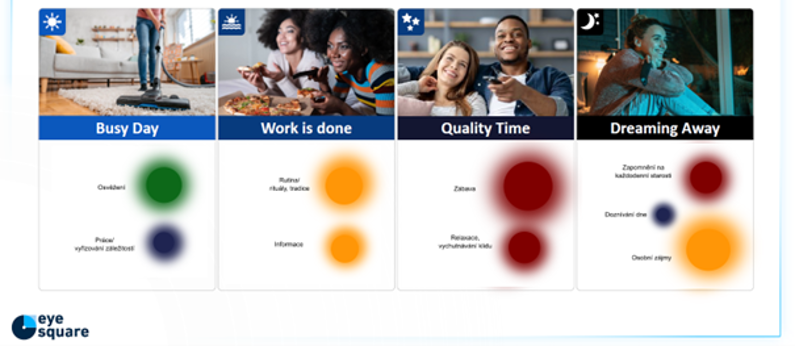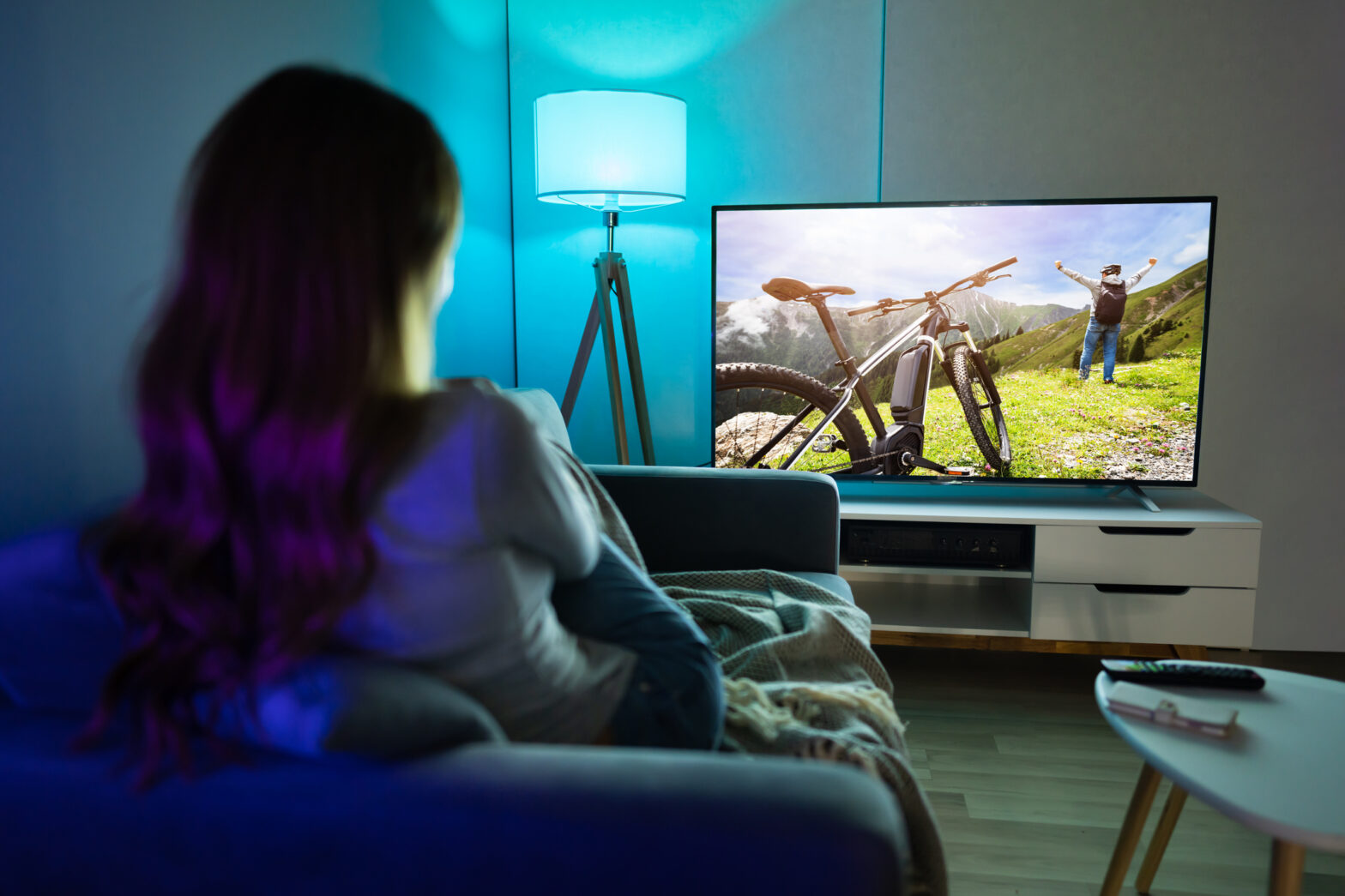The aim of the study, which was a successful follow-up to the 2022 Mapping the Moods study, was to find out in which context certain types of ads and creative elements work best - and why. From the results of the study, specific recommendations can be derived for both advertisers and media agencies that can help them significantly optimise the effect of their spots. The results of the study showed that there is a significant correlation between the actual context, the creative design of TV ads, and the impact of the ad on viewers in front of the TV screens.
Course of the study
The experimental study conducted by market research institute Eye Square involved 285 viewers. Respondents were adults in two age groups (18-39 and 40+), who were equally represented in the test groups. Each group also included 50% women and 50% men and an appropriate combination of education, occupation and household income level. 75% of the participants were from Germany, while 12.5% were from Austria and Switzerland each. The survey took place in Berlin, Frankfurt, Munich, Vienna and Zurich.
Each study participant received a box containing all the necessary equipment, i.e., a laptop, smartphone, webcam and skin conductance measurement device, and instructions to install the equipment at home. The study leader then checked the correctness of the installation via smartphone.
Participants watched 64 test spots in four scenarios. These scenarios covered different times of the day and typical TV use situations. In total, the study included more than 1,000 media sessions and more than 8,300 advertising contacts, making it the largest study of its kind to date in the European German-speaking region (Germany, Austria, and Switzerland).
The study was also complemented by an online survey that measured classic parameters of advertising influence, such as ad recall and purchase intent.
Detecting visual attention paid to the TV screen during advertising
The study applied four typical scenarios a viewer might experience during the day: Busy Day (the busiest phase of the day, the viewer is busy, doing a range of activities), Work is Done (a moment that usually occurs in the early evening when the work is done and the viewer moves into a relaxation phase), Quality Time (a time of rest when the viewer enjoys a moment of relaxation, usually in the company of family members), and Dreaming Away (a resting mode, the fading of the day, the viewer is usually alone).
 Every participant used TV in four different situations; Source: Mapping the Impact
Every participant used TV in four different situations; Source: Mapping the ImpactThe effect of TV ads in each scenario tested
Busy Day scenario
2 to 6 pm, Monday to Friday, alone, neutral mood, high viewer activity and busyness, shows watched: Big Bang Theory, Das Strafgericht, Shopping Queen, Britt – der Talk.
The effect of advertising spots in this scenario: If the TV is on during the day and within the user’s reach, the spots should match the user’s state of mind and situation. Strong visual effects, brand integration, an engaging or special soundtrack, and realistic or natural product presentation have proven to be elements with a particularly positive impact. On the other hand, spots that are too short and uninteresting, elements with particularly artistic aesthetic quality, and too little emphasis on the brand have a lower impact. The ideal advertisement is “a spot explaining the substance and telling a real-life story”.
Work is Done scenario
6 to 8 pm, Monday to Friday, in the company, positive mood, moderate activity, light viewer busyness, shows watched: Die Simpsons, Berlin Tag und Nacht, Das perfekte Dinner, K1 Magazin, Galileo.
The effect of advertising spots in this scenario: In this scenario, spots that spread a positive mood work well. Longer spots that present products as a ‘nice choice’, elements with high aesthetic qualities/attractiveness, humorous elements that put a smile on the viewer’s face have a particularly positive impact. On the other hand, pure branding spots without product references and exaggerated creativity have a low impact. The ideal advertisement is a spot that evokes the feeling of “I can see something amazing, beautiful and interesting”.
Quality Time scenario
8 to 10 pm, Thursday to Saturday, in the company, very positive mood, high activity, low busyness, shows watched: Iron Man, Top Dogs Germany, CSI:Miami, Indiana Jones 3, Joko gegen Klass.
The effect of advertising spots in this scenario: In this situation, emotional moments with a movie feel are considered to be a personal experience. Spots of 20 seconds or more and polarizing or very likable protagonists have a particularly positive effect. Among the creative elements, humour and also drama, suspense and surprise work well. On the other hand, spots that are too short and have too much factual content (such as information on product certification, etc.) have a low impact. The ideal advertisement is a spot that delivers an “engaging experience to be talked about later”.
Dreaming Away scenario
8 pm to 1 am, Monday to Saturday, alone, neutral mood, low activity, zero busyness, shows watched: Late Night Berlin, Criminal Minds, Blade Runner, Medical Detectives, From Dusk till Dawn.
Effect of advertising spots in this scenario: Ads broadcast late in the evening should give off a good vibe. Spots longer than 30 seconds, aesthetic images, and likeable protagonists combined with the artistic and creative world have a particularly positive effect. On the other hand, spots involving mundane settings, a low aesthetic level, overly showy elements, exciting stories, and additional information have a lower impact. The ideal advertisement is “a spot that is not too loud or impulsive, leaves me calm and puts me in a pleasant mood”.
The study also drew some general conclusions about audience attention, memorability and the effects of various creative elements.
Attention and memorability:
Visual attention is the highest late at night (75% between 4-6 pm and 86% after 10 pm).
The rate of digital communication with other people gradually decreases towards the evening.
The highest ad recall rate is late in the evening (65% in Busy Day, 73% in Work is Done, 75% in Quality Time and 75% in Dreaming Away).
The highest perception of detail is in Quality Time (65 %).
Effect of creative elements:
HUMOUR is generally a positive element - it benefits the brand image while brand credibility does not suffer. Humour also generates interest in the brand.
DISTINCTIVE SOUNDTRACKS in spots are generally appropriate, popular songs are particularly well received.
IMAGE CAMPAIGNS are more popular, while performance spots increase purchase intent. Campaigns seeking to combine image and performance elements perform worse than those focusing on only one of them.
REAL EXPERTS in TV ads generally work well, with the highest impact in the Busy Day scenario.
Conclusion
The results of the study show that TV advertising has a strong impact in principle and is effective in all scenarios, however, there are some differences. Creative designers have the chance to achieve a significant increase in the impact of an ad if they take into account the current frame of mind of the audience and use appropriate creative elements of the ad spot to boost the effect of the ad in a given situation.
This is confirmed by the words of the company’s CEO, Malte Hildebrandt:
“Thanks to the two years of effort we have put into the studies, we have managed to combine two sides of the same coin: Last year, we focused on user behaviour in the Mapping the Moods study and demonstrated that this approach can be a useful complement to media planning. The Mapping the Impact study builds on this research and explores the link between context, creative elements and the impact of advertising. These two synchronised studies now, for the first time, provide advertisers with a tool to achieve a significant increase in impact.”
For more information on the Mapping the Impact study and to download the presentation, please visit the company’s website Screenforce.de.

